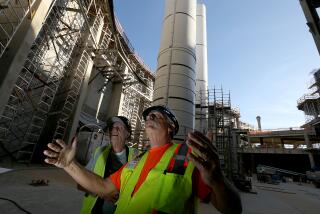Astronauts Snare Russian Module for Space Station
- Share via
HOUSTON — Endeavour’s astronauts captured the first piece of the International Space Station on Sunday, the Russian-made Zarya control module that had to be connected to the Unity chamber aboard the shuttle.
Commander Robert Cabana steered Endeavour to within several feet of the solar-winged module. Then Nancy Currie reached out with the shuttle robot arm and gently latched onto it as the spacecraft soared 240 miles above the Kazakh-Russian border.
“We have Zarya,” announced a jubilant Cabana. “We’re halfway home for the day.”
The most difficult part of the mission--stacking the two giant cylinders--was still ahead. The job fell to Currie, the shuttle crane operator who had deftly hoisted and repositioned Unity in the cargo bay Saturday.
The two station pieces are so big--77 feet from the tip of one to the tip of the other with a combined mass of 70,000 pounds--that Currie and her crew mates had to rely on a computerized vision system and camera views, rather than direct line of sight. Such a “blind” space docking had never been attempted before.
Before beginning their final approach to Zarya--Russian for sunrise--the astronauts had to steer clear of a chunk of a rocket launched last month from California.
Mission Control ordered the pilots to fire the shuttle thrusters to put an extra three miles between Endeavour and the space junk, putting the craft five miles from the orbiting debris. The smaller gap would have been “probably a little too close for comfort,” Mission Control said.
The bigger worry was over Endeavour’s pursuit and capture of Zarya, and its coupling with Unity.
The shuttle’s 50-foot robot arm had never before handled an object the size of the 41-foot, 44,000-pound Zarya, a power and propulsion module that was launched from Kazakhstan on Nov. 20. It will provide all of the necessary electricity and steering for the fledgling space station until a permanent control module can be launched in the summer.
NASA estimates that 43 more launches and 159 more spacewalks will be needed to assemble the orbiting complex.
More to Read
Sign up for Essential California
The most important California stories and recommendations in your inbox every morning.
You may occasionally receive promotional content from the Los Angeles Times.










